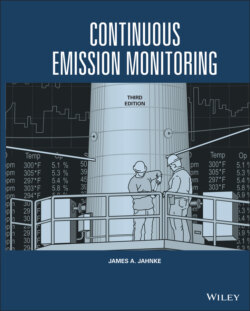Читать книгу Continuous Emission Monitoring - James A. Jahnke - Страница 122
LIGHT SCATTERING BY PARTICLES
ОглавлениеThere is another way that light energy is removed from a beam of light, other than by absorption from individual molecules. If particulate matter, aerosols, or droplets are present in the flue gas, light incident on these materials can be scattered in various directions. As a result, not all of the light will continue in its initial direction and its transmittance through the gas will be reduced. The mechanisms of light scattering are dependent upon the particle refractive index, the particle size (as defined by its radius, r) and the wavelength (λ) of light that impinges on it – different phenomena come into play, depending on how r compares to λ. Three basic types of scattering processes occur (see Figure 4‐10).
1 Rayleigh scattering. If the particle is smaller than the light wavelength, then the particle–light interaction can be characterized as “Rayleigh” scattering (Figure 4‐10a: r/λ ≤ 1), where the light is scattered isotropically equally in all directions.
2 Mie scattering. If the particle size and light wavelength are comparable, r/λ ≈ 1, Mie scattering occurs. In this scattering, electrons in the particle see varying electric fields from the impinging electromagnetic field. Electrons accelerated in an electromagnetic field will emit light, which combines constructively or destructively as it comes from different locations within the particle. The scattering pattern is somewhat complex as shown in Figure 4‐10b where r/λ ≈ 1.
3 Macroscopic scattering. When particles are very much larger than the light wavelength, r/λ ≥ 1, the concepts of geometric optics (such as reflection and refraction) can be used to explain how light scatters (Figure 4‐10c).
Figure 4‐9 Calibration plot for the Beer–Lambert relation.
Figure 4‐10 Three regimes of light scattering. (a) Rayleigh scattering r/λ ≤ 1. (b) Mie scattering r/λ ≈ 1. (c) Geometric optics r/λ ≥ 1.
In a typical flue gas, particle sizes may range from 0.1 to 10 μm or greater. When visible light ranging from 400 to 700 nm (0.4–0.7 μm) is directed through a gas, all of the aforementioned scattering processes can take place, with respect to the particle size distribution. These three scattering processes are described in the following sections.
